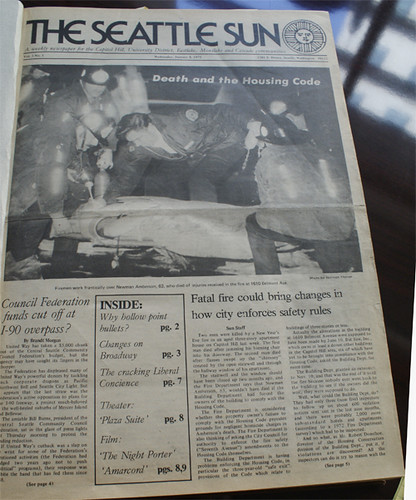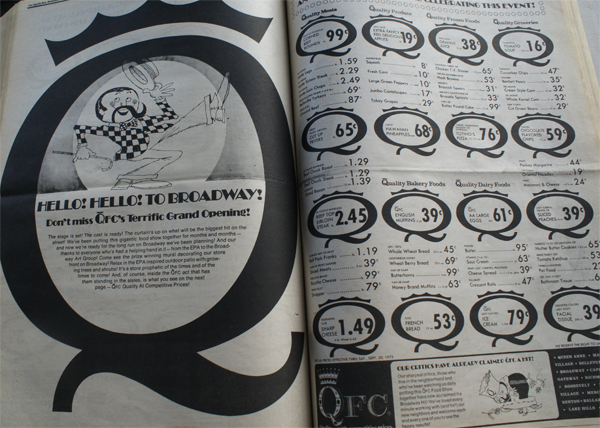
Though the sun has set on Seattle’s first alternative newspaper, City Council member Nick Licata still remembers the weekly that printed from 1975 to 1982 as being a champion for the arts scene and provider of hyperlocal before CHS was even a glimmer in jseattle’s eye.
Licata founded the Seattle Sun in 1973 and printed a trial broadsheet edition at the end of the year before it began to print weekly in 1974. The money for the venture came from the Seattle Information Project, a project originally formed by Licata to print the People’s Yellow Pages.
For a time, the paper was a competitor to the Seattle Weekly, which began printing in 1976.
Looking through the pages of the old paper is striking. Civil rights events and dealings with shady landlords and other darker stories graced the front pages often but the tone of the old issues is also humorous and speaks to a somewhat unchanged Capitol Hill counter-culture. In an October 5, 1975 issue of the paper, a story appeared about women dumpster diving for free food. These days, that would be called “freeganism” and was reported on just last year by Seattle University’s student newspaper, The Spectator.
The paper included sections including “The City,” which covered Capitol Hill, University District, Central District and sometimes downtown or Queen Anne news, “The Neighborhoods,” “Letters” to the editor, ” an events calendar and a general arts and entertainment section that worked to popularize the Seattle live theatre scene.
The Seattle Sun printed 20,000 copies each week originally and, towards the end, circulation was around 24,000 copies. For comparison’s sake, the Seattle Weekly currently distributes 80,000 copies each week. The Stranger’s run totals, by the way, are about the same. (The Stranger wasn’t founded on Capitol Hill, you might be interested to know. Its hyperlocal start was in the U District in the early 90s. We’ll dig deeper into the history of that Capitol Hill media institution later.)
Licata says 1975 to 1979 was the paper’s high point but things began to slow down in the 80s.
 A two page ad advertises the September 1975 grand opening of QFC on Broadway.
A two page ad advertises the September 1975 grand opening of QFC on Broadway.
“People were no longer willing to work 20 to 30 hours a week as volunteers,” he said. “It was beyond a labor of love at that point. […] It was love slavery.”
Eventually, the Sun spun off its music section into a separate paper called The Rocket to make money. The venture didn’t pan out, Licata said, and the jettisoned Rocket was able to outlive the Sun.
The former address of the Sun, 1201 East Denny Way, is now a residence that sits across the street from the Artist Trust and Louis Collins Books.
This is about all we know about the Sun. There is almost no information about the paper online and efforts to contact other contributors met mostly dead ends. So, for you long-time Capitol Hill residents, do you remember it? Did you contribute? Any lessons from the Sun that CHS should consider?



Have you taken a look at the Seattle Sun records housed at the UW Special Collections?
This info from the UW library catalog indicates they have:
Correspondence, minutes, financial records, production records, and related files of the Seattle Sun, 1974-1982.
Nice history but I think Seattle’s first alt paper was Helix, founded by Paul Dorpat in 1967 in the U-District.
I don’t think HistoryLink.org has anything about the Sun in their media section. Maybe you could share your article over there?
I worked at The Seattle Sun for a year in the late ’70s. Walter Hatch, who went on to the Seattle Times and now teaches at Colby College in Maine, was there. Robert Ferrigno, now a best-selling novelist living in California, was the music editor who I recall was the driving force behind The Rocket, which spun off around that time. Matt Groening appeared from time to time. Cartoonist Lynda Barry was around a lot.
It was a great place to work.
Following up on my previous post, when I worked at the Sun, the offices were on the corner of 15th and Mercer, above the Canterbury. We typed our stories on the back of recycled mail. Yes, typewriters.
I worked for the Sun in the mid 1970s. I recall seeing Ray Mungo (co-founder of the Liberation News Service) around the office. It was a wonderful place to work.
I’ve just discovered a picture of my folks, Louise and George Crowley, from the October 29, 1975 issue of the Sun. As I have very few pictures of them and their grandchildren never met them, any help tracking down the photographers and/or negatives of the days would be greatly appreciated.
Happy to take about “the day” (206)660-0253
Barry Johnson (now at the Oregonian unless he has retired) was the publisher when I was there in the late 80’s. He has a better memory than I do. We were all young and broke. Good memories.